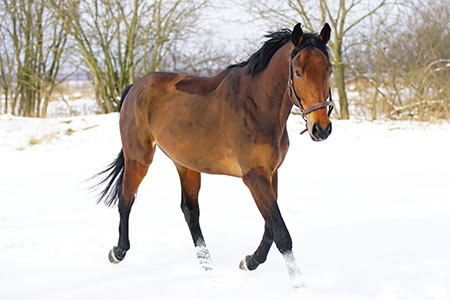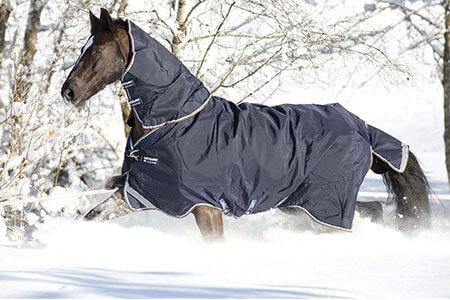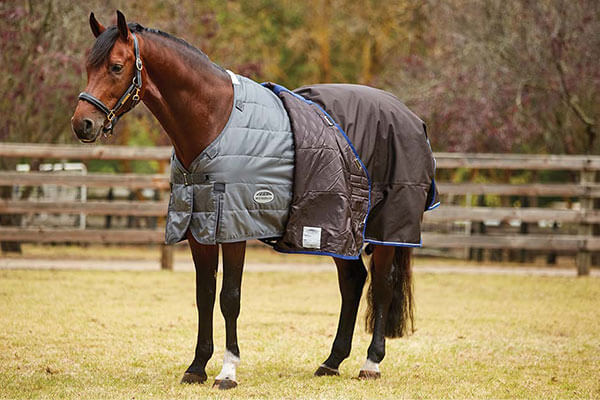Choosing the Right Turnout Blanket for Your Horse: A Comprehensive Guide
Posted by Sprucewood Tack Shop on 2024 Nov 13th
As the temperature drops, you should consider buying winter blankets for your equine companion. Selecting appropriate blankets for your horse is a crucial decision that directly impacts their comfort and well-being. If your horse spends time outside, a turnout blanket can protect them from adverse weather conditions, keep them warm, and maintain their coat and health. But, with so many turnout blanket options on the market, figuring out what’s best for your horse can be confusing. This guide will walk you through the different types of turnout blankets, turnout blanket composition, and the vital aspects to consider when choosing them.
What is a Turnout Blanket?
A turnout blanket is a durable and waterproof covering that is designed to protect horses from rain, snow, mud, and cold temperatures while they are kept outside or 'turned out.' The primary function of these blankets is to provide insulation and keep your horse dry. Unlike stable blankets, turnout blankets are often made with more robust materials to withstand outdoor conditions.
Types of Turnout Blankets:
There are various weights of turnout blankets available, and each type serves a different purpose.
Lightweight Turnout Sheets (A.K.A. Rain Sheets)
Lightweight turnout sheets typically have 0-50 grams of insulation and are generally suited for temperatures between 5 to15°C. They offer protection from rain and wind but minimal insulation.
Medium-Weight Turnout Blankets
With 100-250 grams of insulation, medium-weight blankets are designed for temperatures between -5 to 5°C. These blankets offer extra warmth while still protecting against snow and sleet.
Heavy Turnout Blankets
Ideal for colder temperatures, Heavy-weight turnouts provide maximum warmth, often containing 300+ grams of insulation. These blankets are ideal for keeping your horse warm in the harshest winter conditions.
Blanket Liners - A Versatile Option
Many blanket brands have the option to add a compatible blanket liner to their turnout blankets that will increase the insulation and warmth. They are a simple way to adjust your horse’s blanket weight without purchasing a whole new blanket. They easily attach to outer blankets with clips or velcro and are ideal for transitional seasons like spring and fall.
Material Composition of Turnout Blankets:
Turnout blankets are made from different outer shell fabrics, usually polyester, polypropylene or nylon, and differ in waterproofing and breathability. Understanding these components will help you select the right blanket for your horse’s needs.
Denier: Understanding Fabric Strength
Blanket descriptions often list the “Denier” of the outer shell of the blanket. It is often shown as a number followed by the letter “D”. But what is a denier? Denier is a unit of measure that expresses the fibre thickness of threads used in the fabric. A 600D material means there are 600 yarns within each thread used in the fabric. It is a common misconception that the higher the denier, the tougher the blanket is. The strength of the fabric is not only dependent on the weight (denier), but the type of yarn used. (For instance, a 2500D Polyester blanket might not be as robust as a 1000D Polypropylene one.) Polyester is the most common fabric used in blankets, but it is not generally as strong as polypropylene or nylon. As well, within each type of material, there are different grades of fabric making it even more difficult to compare blankets for durability. For instance, not all “ballistic” nylon is created equal. This is why it's crucial to purchase a turnout blanket with a reputable brand name. This ensures not only quality and durability but also reliability in your purchase.
Ripstop Fabric: Durability and Resistance
Another term you may see when looking at blanket descriptions is “ripstop”. The ripstop weave is a technique that reinforces the fabric at regular intervals to help the material resist tearing. It can be seen on the blanket shell as small squares or zigzags.
Waterproofing & Breathability:
When choosing a turnout blanket, it's crucial to ensure it includes a waterproof and breathable shell. The quality of the waterproofing membrane or coating will directly impact the blankets’ ability to repel water while allowing moisture to evaporate from your horse. Selecting a turnout blanket with good breathability and moisture-wicking properties is essential for your horse's comfort and well-being. Breathable blankets allow for the evaporation of sweat and moisture, preventing the accumulation of sweat under the blanket and reducing the risk of skin issues. Moreover, blankets with moisture-wicking linings can keep your horse dry and comfortable even during periods of exertion or fluctuating weather conditions. A fabric with a high waterproof and breathability rating, while more expensive, is a worthwhile investment in your horse's comfort and well-being.
Factors to consider when choosing a Turnout Blanket:
The perfect turnout blanket might be different for every horse, depending on their individual needs as well as the climate. The most important things to consider when browsing all the blanket options are:
Temperature and Weather Conditions:
The first and most critical factor to consider when choosing a turnout blanket for your horse is the prevailing temperature and weather conditions in your area. Understanding the typical weather patterns in your region will help you select the appropriate blanket weight to keep your horse comfortable and protected from the elements. In regions with milder winters, a lightweight turnout sheet may be sufficient to provide protection from light rain and wind while allowing your horse to move freely. However, in colder climates, a medium to heavyweight blanket with added insulation will be necessary to keep your horse warm and dry.
Your Horse's Activity Level and Interaction with Other Horses:
The next important consideration is how active your horse is while turned out and whether they are turned out with other horses. Horses that are turned out with playful herdmates may be more likely to get their blankets snagged or torn. In such cases, opting for a turnout blanket with a durable outer shell can help withstand the wear and tear of roughhousing and playful antics in the field. For horses that are more sedentary while turned out or are kept in smaller groups with less interaction, a standard turnout blanket may suffice.
Assessing Your Horse's Condition and Hair Growth:
The condition of your horse, including their age, body condition, and hair growth, will also influence your turnout blanket choice. Older horses or "hard keepers" may require additional insulation to stay warm, while horses with a thick coat or who are active in the paddock may need a lighter blanket to prevent overheating. Like people, some horses' metabolisms “run hot,” and they require lighter weight blankets.

Clipping and Riding Activity:
If your horse is clipped or regularly worked, their heat regulation may be affected, making a well-fitted turnout blanket essential for maintaining their body temperature. Clipped horses will require heavier blankets to compensate for the lack of natural insulation. Horses in regular work may also need heavier blankets to discourage hair growth to prevent sweating during exercise.
Duration of Turnout and Availability for Blanket Changes:
The amount of time your horse spends turned out, and the availability of someone to change their blanket as needed are crucial factors to consider. Horses turned out 24/7 or for extended periods without access to shelter will require blankets with higher waterproof and breathable properties to protect them from rain, snow, and fluctuating temperatures. If someone is unavailable to monitor your horse and change their blanket as the weather changes, you will also need to select a blanket with superior waterproofing and breathability.
Choosing the Right Fit & Style:
In addition to considering the technical aspects of the blanket, it's important to ensure the proper fit and style for your horse. A well-fitted blanket should provide ample coverage without restricting movement, and it should have adjustable features to accommodate your horse's unique body shape. Additionally, considering features such as shoulder gussets, tail flaps, and secure fastenings can enhance the overall comfort and functionality of the blanket. Be sure to measure your horse and consult size guides from different brands to ensure the perfect fit.
Conclusion:
The right turnout blanket is essential for keeping your horse comfortable and protected during the winter months. By considering factors such as the weight of the blanket, material composition, and your horse's individual needs, you can make an informed decision. Remember to prioritize waterproof and breathable materials to ensure your horse stays dry and comfortable. Investing in a high-quality turnout blanket is an investment in your horse's well-being, so take the time to choose the best option for them.



